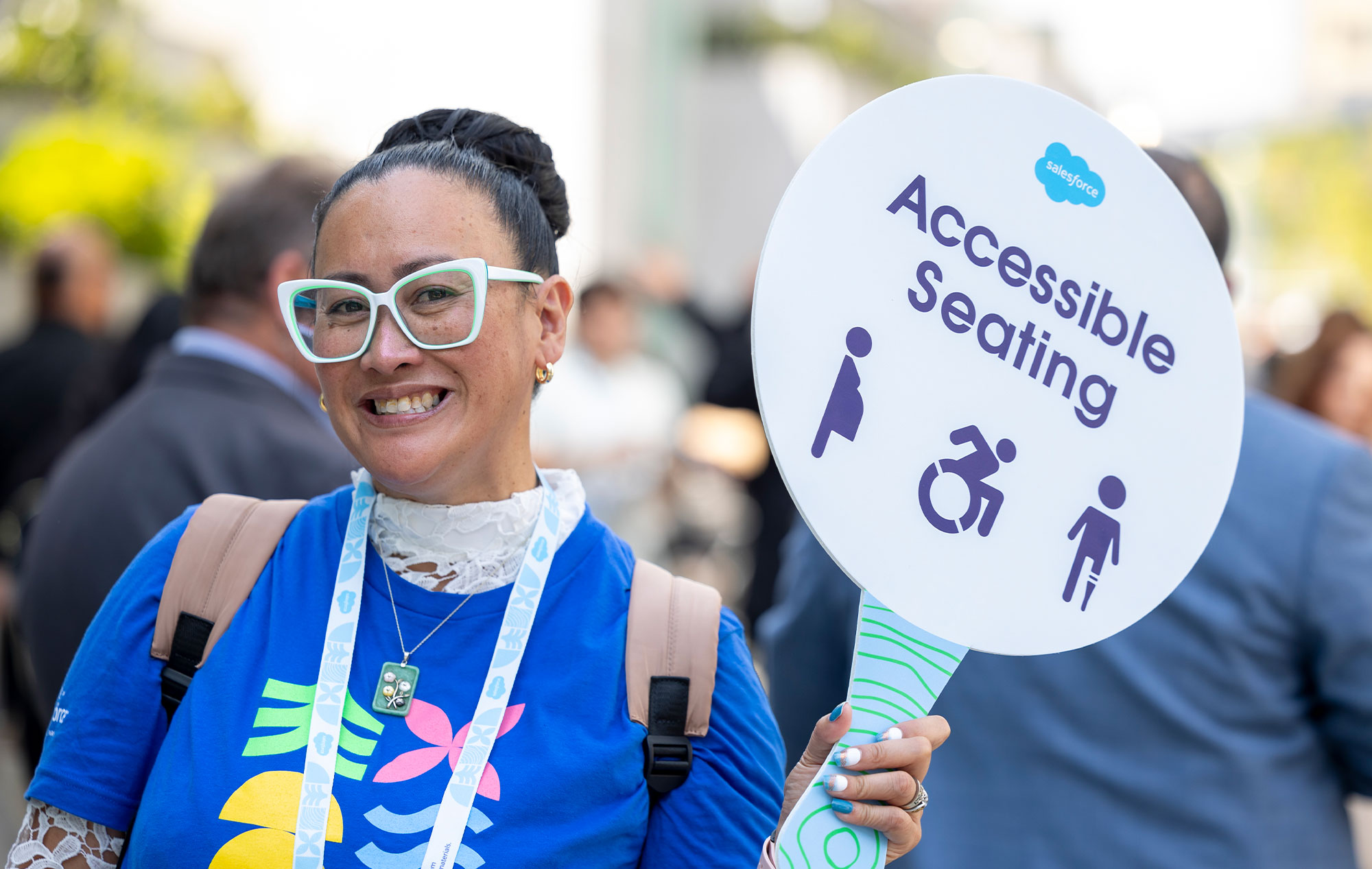If your organization is genuinely committed to creating a workplace culture that is accessible and inclusive, then you should create a disability inclusion plan, a document that lays out your vision and concrete goals for transforming your company.
Sure, your business can become more accommodating for professionals with disabilities without a disability inclusion plan, but your efforts will be inconsistent and fragmented.
Without effective documentation and communication (which we’ll get to in a moment), present passion for greater accessibility and inclusion has an increased chance of fading away or being deprioritized, with employees likely falling back into long-standing workplace norms and habits that overlook the barriers people with disabilities routinely encounter in the workplace and broader society.
Your disability inclusion plan should outline how your business will ensure that professionals with disabilities are able to participate fully in all aspects of its operations. This not only benefits your employees but enables you to better connect with the large number of people with disabilities presently undervalued or disregarded by the marketplace.
After all, more than 42 million Americans live with a disability, according to a July 2023 report from Pew Research Center.
Having a disability inclusion plan will not only help you attract more professionals with disabilities, but retain them, as well. There are abundant reasons for hiring them.
However, lingering biases remain among the biggest barriers to increasing workplace participation from disabled professionals.
“I think it is the perception that people with disabilities are not as productive,” explains Crystal Preston-Watson, a Senior Digital Accessibility Analyst at Salesforce who was born with ocular toxoplasmosis (a visual impairment in both eyes). “That is a huge amount of it. And it just really is not the case.”
On the whole, she doesn’t sense disability is something that prevents professionals from meeting the demands common to employment.
“It's like, ‘Oh, someone who is blind, well, they're not going to be able to do anything, there's no way,’” she continues. “There's the perception that if you're blind, you can't be a developer. I know quite a few blind developers who are better than I could ever be.”
So, how do you forge an effective disability inclusion plan?
Steps for Creating a Disability Inclusion Plan
Evaluate how you’re currently doing. Conduct a self-assessment of the present state of disability and digital inclusion across each of your teams or departments, identifying strengths, gaps, and opportunities for improvement.
Be honest with yourselves. As with any diversity, equity, inclusion, and belonging (DEIB) work, becoming an authentic champion demands candid reflection and acknowledgement of the praiseworthy, as well as areas for growth.
Seek out feedback from all directions. Engage with stakeholders, including employees, customers, suppliers, and partners, to solicit feedback and input that will inform your disability inclusion plan.
The more diverse your feedback sources, the better.
This should include people with disabilities and their allies, as well as experts and advocates in the field of disability rights and inclusion. Ask them about which ways you’re failing to accommodate people with disabilities, where you’re excelling, and what they think your organization can do to improve.
Holding focus groups, for instance, is a profound way to gather feedback. While quantitative data, such as surveys, can be helpful, qualitative methods can be more powerful.
“It is just as valuable to collect qualitative data and testimonials,” explains Camille Edwards, a DEI educator with more than 16 years of experience. “Run focus groups. Collect testimonials. Interview people. Ask them how long they've been in an organization and how they would describe the culture five years ago versus today.”
The open-ended nature of qualitative research facilitates potent emotional insights and perspectives that can’t be anticipated within quantitative frameworks.
Develop a vision, mission, and goals. These should align with your company’s values and strategic objectives. The vision should describe the desired future state of disability inclusion on your teams while the mission should explain the purpose and scope of your disability inclusion plan. Your goals should specify the measurable outcomes and indicators of success.
For instance, your vision can be something as straightforward as: “We have a vision that all employees, stakeholders, and customers with disabilities will be able to fully access our products and fully engage with [company name].”
Your mission statement might resemble: “To create a more accessible and inclusive company culture, we will ensure that all of our policies, standards, and products are responsive to the needs and preferences of people with disabilities.”
And your goals could include a benchmark such as “increase the representation of team members with a disability by 25% by 2030.”
“Your mission is your manifesto, right,” Edwards explains. In an ideal world, “where everything is happening the way that it should, this is your North Star. This is what we're here to do. This is who we're here to be. This is what we're always reaching and striving for.”
Put your plan into action. Design and implement initiatives to achieve the goals of your disability inclusion plan, based on findings from your self-assessment and stakeholder feedback. You may implement several new policies all at once, such as introducing more flexible remote work options and integrating real-time closed captioning into all of your meetings.
Alternatively, you may roll out fresh initiatives sequentially, their success depending on how well they build upon each other. Perhaps, you introduce hybrid remote work options with the goal of eventually being able to hire employees who are remote full time.
Given the huge benefit remote work options are for professionals with disabilities, this policy is a staple for disability inclusion plans.
Edwards tells organizations to exercise caution when implementing DEIB initiatives, such as a disability inclusion plan. While looking to improve company culture, you must be certain you’re acting in ways that are honest with your personal and organizational values.
“I think that it is very human for us to want to be viewed in a certain way, to want to be seen as progressive or on the right side of something,” she says. The desire “to know that people think you’re a good person” can sometimes animate us to act in hurtful or unproductive ways.
“Nobody wants to be labeled as bad,” she continues. “Nobody wants to be labeled as incorrect. Naturally, in our brains, we're preserving that part of ourselves. That comes up with bias work all the time.”
Adopting postures that aren’t consistent with what you value as a person or organization is commonly referred to as “virtue signaling” in DEI circles, Edwards explains, adding:
“You start to do things that are not true to you because you don't want to be mislabeled or misrepresented as something that you know is negative. But then you start doing things that end up being mission misaligned.”
Monitor and evaluate your progress. At intervals after establishing your disability inclusion plan, typically every six to 12 months, appraise its impact using data and feedback outlined in your original goals.
You should have already identified a team member or internal team who will track the performance and desired outcomes detailed in your plan. They will communicate this to stakeholders, including your senior leadership, and recognize the contributions and successes of people with disabilities and their allies.
One effective way to determine whether employees understand what you’re trying to communicate about and accomplish with your disability inclusion plan or not, is if they can explain it in their own words.
If employees and team members can't speak clearly about your values, mission, or vision, then “it means they haven't been enrolled,” Edwards says. “It's similar to when you go shopping and you're like, ‘Oh my gosh, that color looks great on her. I'm gonna buy a coat in the same color.’ That wasn't your color.”
Review and update your disability inclusion plan regularly. This ensures that it remains relevant, responsive, and effective. Your organization should also seek continuous improvement and innovation in disability inclusion.
You’ll soon realize how easy it is to make mistakes when attempting to become a more accessible and inclusive organization.
Notably, when your report comes back negative, or doesn’t show as much progress as you’d like, frame areas where you fell short as opportunities for growth, and recommit yourselves to doing better, which is not an uncommon occurrence in social impact reporting.
Your ultimate success, however, will hinge largely on how well you communicate your disability inclusion plan.
Communicating Your Disability Inclusion Plan
Implicit throughout the creation and implementation of your disability inclusion plan is how you communicate it to both internal team members and external stakeholders. Here are a few things you can do to guarantee your organization does that effectively.
Keeping Internal Teams Informed
Ensure your internal communications are accessible. Messages about your disability inclusion plan should be available and understandable to everyone, regardless of their disabilities or preferences.
Use captions, transcripts, alternative text, and other accessibility features for your videos, presentations, and visuals. Offer different channels and formats for people to access and respond to your communications such as email, website, phone, or chat. This is also a good exercise for revealing accessibility barriers employees and stakeholders may have when operating within your workplace ecosystem.
Establish an employee communications plan. This should explain the purpose and benefits of your disability inclusion plan, and how it aligns with your organization’s values and goals. Share some facts and data about disability inclusion in the workplace, and dispel some common myths and misconceptions.
For instance, you may point out that just 19.1 percent of disabled professionals are employed as compared to 63.7 percent of their non-disabled peers, according to a 2021 Bureau of Labor Statistics report.
Be transparent about your organization’s current situation, progress, and challenges, and demonstrate your commitment and accountability to your disability inclusion plan.
Integrate it into your current meeting structure. Rather than build out a new series of meetings, incorporate disability inclusion discussions into regular meetings with managers, teams, and executives. Additional meetings may unnecessarily tax team members and undermine enthusiasm for new disability inclusion initiatives.
Plus, baking your disability inclusion plan into pre-established meetings further reinforces messaging about your goal to transform every part of your organization around greater accessibility and inclusion.
Provide team members with tools and resources to facilitate these conversations, such as FAQs, scripts, talking points, and best practices. Encourage people to share their feedback, questions, and suggestions, and to support and participate in your disability inclusion initiatives.
Employ visuals and other marketing collateral. Create and distribute promotional materials that highlight and explain your disability inclusion plan, such as pamphlets, posters, flyers, or videos.
Use consistent and inclusive branding, language, and imagery for your materials. Place them in common spaces where employees can see and take them, such as bulletin boards, break rooms, or lobbies. These materials can complement and reinforce your messages delivered in other channels.
Communicate frequently and consistently. Keep your employees informed and engaged about your disability inclusion plan by sending regular updates and reminders through various channels.
Share your achievements, challenges, and lessons learned, and celebrate and recognize the contributions and successes of people with disabilities and their allies. Solicit feedback and suggestions from your employees, and use them to improve and update your disability inclusion plan.
Including these updates in other company-wide emails, for instance, further demonstrates your commitment to supporting professionals with disabilities.
Talking With External Stakeholders
Develop a clear and consistent brand for your disability inclusion plan. Your disability inclusion plan should have a recognizable and clear brand that reflects your organization’s values and goals. Create a dedicated web page or section on your website where the disability inclusion plan and its updates are posted and accessible to the public.
Highlight and showcase your achievements and impact. Share your success stories and testimonials from professionals with disabilities and their allies, and feature how your disability inclusion plan has improved their lives and experiences.
As with internal team members, this can also be communicated using pamphlets, posters, flyers, or videos, to explain and promote your disability inclusion plan and its benefits. Consider publishing a report or a newsletter dedicated to your disability inclusion plan, highlighting achievements, challenges, and lessons learned.
Disability inclusion plans are often included alongside a company’s annual social impact report, which is a more comprehensive overview of an organization’s socio-economic effects on society and the natural environment.
Engage and collaborate with your external stakeholders. Solicit feedback and input from disability organizations, customers, suppliers, and partners. Invite them to participate in events or webinars to showcase and discuss your disability inclusion plan and its outcomes.
Inform them about your policies and expectations regarding disability inclusion and encourage their support and cooperation.
Communicate frequently and strategically. Keep your external stakeholders informed and engaged by sending regular updates and reminders through various channels.
Use different formats and styles to suit different audiences and purposes, such as website, blogging, articles, video clips, direct emails, policy papers, research, advertisements, or public service announcements.
Again, align your communications with organizational objectives and priorities, and tailor them to the current context and needs of your external stakeholders.
At the end of the day, if you're not regularly talking with team members and external stakeholders about your disability inclusion priorities, then odds are you’re going to be far less effective at creating a more accessible workplace. Crafting an informed disability inclusion plan is just the beginning of that journey.
Salesforce is a founding partner of InclusionHub, a resource for digital accessibility dedicated to helping businesses prioritize disability inclusion. To learn more about accessibility issues, visit Salesforce’s a11y website.






Leave a Comment